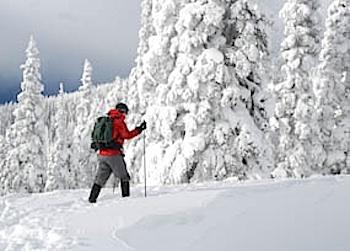In a move not popular with all locals, Olympic National Park officials have decided they cannot afford to maintain daily access to Hurricane Ridge during the winter months.
Park officials say that a two-year trial period for the access failed to demonstrate a great enough interest in visitors to justify the expense of keeping the 17-mile-long road plowed for skiers, snowboarders, and snowshoers. As a result, when the winter season begins in late November the access to Hurricane Ridge will be limited to Friday through Sunday.
“Despite the best efforts of our local community, Olympic National Park employees and National Park Service staff in Washington, D.C., weekday winter access to Hurricane Ridge did not lead to a sufficient increase in visitors,” said Todd Suess, the park's acting superintendent. “Unfortunately, given the fiscal realities of today, we cannot justify the use of over $325,000 in community donations and taxpayer money to maintain weekday winter access to Hurricane Ridge Road for a relatively small number of people.”
However, proponents of keeping the road open daily through the winter maintain the park either failed to open the road half of the time in winter or opened it later than scheduled during the trial period. They also maintain that visitation to Hurricane Ridge during the two years was up 35 percent, although park officials say it was just 19 percent.
At the urging of Port Angeles area community leaders, the Washington, D.C. office of the National Park Service provided a two-year $250,000 annual funding increase to the Olympic National Park budget, contingent on $75,000 in matching funds from the local community. The community met this challenge each year through aggressive fund-raising campaigns that netted several large contributions from the cities of Port Angeles and Sequim, Clallam County and many smaller donations from local organizations and individuals.
The temporary increase in funding provided a two-year trial period during which visitor and economic benefits of daily winter access to Hurricane Ridge would be measured and evaluated. Park staff established a visitation benchmark as its measure of success, aiming for the average number of winter weekday visitors to equal at least 45 percent of the five-year average of winter weekend visitors.
“Although we and our community partners joined forces to promote awareness and interest in weekday visits to Hurricane Ridge, we did not reach our 45 percent benchmark,” explained the acting superintendent. "During the two-year trial period, weekday visitation averaged 19 percent of the five-year average for visits on weekend days."
Most of the park’s roads, including those leading to the Hoh Rain Forest and coastal destinations, are located at lower elevations and remain open year round. “Keeping Hurricane Ridge Road open daily through the winter is a very different task than providing daily access to the park’s low elevation roads, and is significantly more costly and difficult,” acting-Superintendent Suess said.
Weather permitting, the Hurricane Ridge Road will be open Friday through Sunday, 9 a.m. to dusk through the winter season, plus additional days during the winter holidays, including the Christmas through New Year’s Day week, and Martin Luther King, Jr. Day and Washington’s Birthday.




Comments
Rod, just for clarification re the costs of plowing, if you say it only costs $75,000 to do the plowing throughout the winter, where/how did the NPS come up with the $325,000 figure?
"Unwilling," keyword here and in a number of other areas now and in recent past. It's become a theme that describes the character of NPS in some issues and in other issues overreach and out of touch to the point of disaster. Can anyone describe the functional core of NPS in real terms and not faux altruistic lingo that discounts cultural, historic connections to our environment. Out of line here and at Drake's Bay in my opinion. Some of my earliest adventures in the Olympics began from Hurricane Ridge.
Kurt asks "Rod, just for clarification re the costs of plowing, if you say it only costs $75,000 to do the plowing throughout the winter, where/how did the NPS come up with the $325,000 figure?"
The Park hired 3 additional road crew, and counts 100% of their cost, although they are actually plowing this road less than 30% of their workday (and many days, not at all) and are working on other Park roads. Also added is the cost of patrolling the road, unlocking the Hurricane Ridge Visitors Center (which was not staffed weekdays, simply left open for warm shelter and restrooms) and staffing the entrance booth to collect entrance fees. Your question is a good one, and this method of accounting is full of contradictions and does not make sense to most observers. For alternatives, see http://freehurricaneridge.blogspot.com/p/ideas-for-cooperation.html and http://www.kitsapsun.com/news/2012/oct/29/seabury-blair-jr-hurricane-ridge-road-closure-it/
To more fully answer Kurt's question, NPS' response to a FOIA request has been posted at http://freehurricaneridge.blogspot.com/2012/11/blog-post.html NPS initially estimated "Total for the season $80,000 for seven day a week operation". The actual expenditures are also disclosed as $294,454 in FY2011 and $320,802 in FY2012.
Reconciling this with the actual performance (50% on time road opening, i.e. poor), and with the cost of weekend operations here and similar operations at other Parks, is difficult. http://freehurricaneridge.blogspot.com/p/road-crew.html